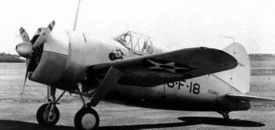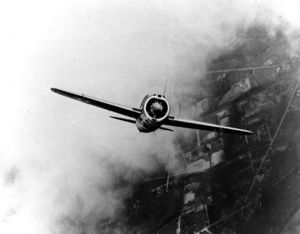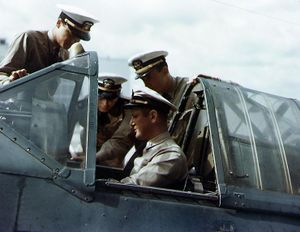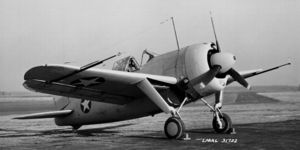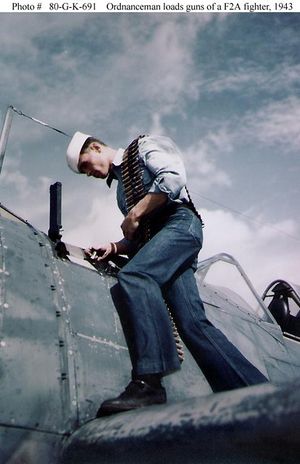PlaneSpottingWorld welcomes all new members! Please gives your ideas at the Terminal.
Brewster F2A Buffalo
| F2A "Buffalo" | |
|---|---|
| F2A-1 of US Navy squadron VF-3. | |
| Type | Single seat carrier-based fighter |
| Manufacturer | Brewster Aeronautical Corporation |
| Designed by | Dayton Brown and R.D. MacCart |
| Maiden flight | 2 December 1937 |
| Introduced | April 1939 |
| Retired | 1948— |
| Status | retired |
| Primary users | United States Navy Royal Air Force |
| Produced | 1938-1941 |
| Number built | 509 |
The Brewster F2A (company Model 139) was an American fighter aircraft which saw limited service during World War II. In 1939, the F2A became the first monoplane fighter aircraft used by the US Navy. In December 1941, it suffered severe losses with both British Commonwealth and Dutch air forces in South East Asia while facing Zekes of the Japanese navy and the army's Oscars. It also saw action with US Marine Corps squadrons at the Battle of Midway. The F2A was derided by some American servicemen as a "flying coffin",[1] due to poor construction and perceptions of its general performance. Despite this reputation, the F2A proved a potent weapon with the Finnish Air Force, against the Soviet Air Forces.
Contents
Design and development
In 1935, the US Navy issued a requirement for a carrier-based fighter intended to replace the Grumman F3F biplane. Two aircraft designs were considered: the Brewster and the Grumman XF4F-1 which was still a "classic" biplane. The Model 139 incorporated sophisticated features for the time: a monoplane configuration, wing flaps, arresting gear, retractable landing gear and an enclosed cockpit.
The US Navy competition was opened up to allow another competitor, the Seversky XFNF-1, a navalized P-35 eliminated early on when the prototype could not reach more than 267 mph.[2]
The Navy awarded Brewster the contract; the Model 139 was redesignated XF2A-1. The prototype first flew on 2 December 1937 and early test results showed it was far in advance of the Grumman entry. While the XF4F-1 would not enter production, it would later re-emerge as a monoplane, the Grumman Wildcat. The Brewster fighter looked "pugnacious" with a stubby fuselage, mid-set wings and a host of advanced features. It was all-metal, with flush-riveted, stressed aluminum construction, although flying surfaces were still fabric-covered. Split flaps, a hydraulically-operated retractable main undercarriage (and partially retractable tail wheel) and a streamlined framed canopy gave the XF2A-1 a modern look. Powered by an 850 hp Wright R1820-22 Cyclone, it had a top speed of 277.5 mph, later boosted to 304 mph at 16,000 ft after improvements were made to the cowling streamlining and carburetor/oil cooler intakes.[3]
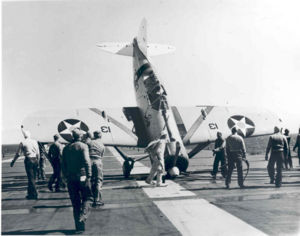
Service testing of the prototype began in January 1938 and, in June, the Navy ordered 54 of the production F2A-1. The initial armament mix of two machineguns, a .30 (7.62 mm) and .50 (12.7 mm) Browning mounted in the cowl and firing through the propeller arc, would later be augmented by the provision of an additional two .50s, one in each wing outboard of the landing gear.
A later variant, the F2A-2, of which 43 were ordered, included a more powerful engine, a better propeller, and integral flotation gear, and was followed by the F2A-3. Unfortunately, the improvements added weight that adversely affected the fighter's performance and caused perennial problems with its landing gear (collapse issues), especially in shipboard service.
Operational history
Of the first deliveries, beginning in June 1939, nine went to VF-3 aboard the USS Saratoga. The balance of 44 were declared surplus and sold to Finland. Although it was becoming clear the F2A was inferior to the latest German fighters, in early World War II, all modern fighter types were in demand, including the F2A. Consequently, the United Kingdom, Belgium, and the Netherlands East Indies purchased several hundred of the land-based versions.
Belgium
Just before the start of World War II, Belgium sought more modern aircraft to expand and modernize its air force. Belgium ordered 40 F2A-2s (which had a factory designation of B-339), with a different engine, the Wright R-1820-G105, with a power output of 1,000 hp. The arrestor hook was removed and the aircraft was modified with a slightly longer tail. Unfortunately, only two aircraft reached France during the collapse of Belgium and they were later captured by the Germans. Six aircraft ended up in Martinique with the French Air Force, where they were eventually destroyed.
British Commonwealth
Facing a shortage in combat aircraft in January 1940, the British government established the British Purchasing Commission to acquire US aircraft that would help supplement domestic production. Among the fighters that caught the commission's attention was the F2A. The balance of the French order was passed to the UK. Appraisal by the British criticised it on numerous points including lack of armament, maintenance issues and cockpit controls while it was praised for handling, roomy cockpit and visibility. With a top speed of about 300 mph and poor performance over 15,000 ft it was considered unfit for duty in western Europe and they were supplied to British Commonwealth air forces in Asia; as well, the UK ordered 170 of the B-339E variant.
The B-339 was fitted with an export-approved 1,100 hp Wright Cyclone engine and modified for land use with navy equipment such as the life raft and arrestor hook removed.[4] The RAF stipulated numerous upgrades to their order, including replacement of the standard ring and bead gunsight with a British Mk III reflector gun sight, and improving pilot protection, by adding reinforced armor plating and installing armored glass behind the canopy windshield.[5]
They were sent to Royal Australian Air Force, RAF and Royal New Zealand Air Force fighter squadrons in Singapore, Malaya and Burma, shortly before the outbreak of war with Japan.
Prior to December 1941, the Western Allied air forces seriously underestimated the numbers, pilots, leadership and capability of their Japanese opponents. Despite having initial successes against the Ki-43 Oscar and Ki-27 Nate, the five British Commonwealth squadrons flying Buffalos in the Malayan campaign, suffered severe losses on the ground and in the air, especially during the first week of the campaign, resulting in the ongoing merger of squadrons and their gradual evacuation to the Dutch East Indies.[6]
The two RAAF, two RAF, and one RNZAF squadrons, during December 1941-January 1942, were beset with numerous problems,[7] including: poorly-built and ill-equipped aircraft; poor supplies of spare parts; inadequate numbers of support staff; airfields that were difficult to defend against air attack; lack of a clear and coherent command structure; antagonism between RAF and RAAF squadrons and personnel, and; inexperienced pilots lacking appropriate training.
The Hawker Hurricanes which succeeded the Buffalos (from 20 January) also suffered severe losses from ground attacks, and were also virtually wiped out.[8]
The Fleet Air Arm used the Buffalo in the Mediterranean defending Crete in early 1941. Four British Commonwealth pilots (Geoff Fisken, Maurice Holder, Benjamin Clare and Richard Vanderfield) became aces in the Buffalo.[9] Fisken, the top-scoring of them, later flew P-40s and became the highest-scoring Commonwealth pilot within the Pacific theatre.
Netherlands East Indies
The Militaire Luchtvaart van het Koninklijk Nederlands-Indisch Leger ("Military Air Service of the Royal Netherlands East Indies Army", ML-KNIL) had ordered 144 Brewster B-339C and 339D models, the former with used engines supplied by the Dutch and the latter with new and more powerful engines that Brewster purchased from Wright. By the time war began, only 71 had arrived in the Dutch East Indies, and not all were in service. A small number served briefly at Singapore before being withdrawn for the defense of Java.
As the Dutch Buffalos were lighter than the F2A-3 used by the U.S., they were able to successfully dogfight the Oscar, although it was still out-turned by the A6M Zero. Apart from their role as fighters, they were also used as dive bombers against Japanese troopships. Though reinforced by the Commonwealth Buffalos retreating from Malaya, the Dutch squadrons were unable to stem the superiority of Japanese forces at ground level, and they flew their last mission on 7 March. Altogether 17 Dutch pilots were killed, 30 Buffalos were shot down, 15 were destroyed on the ground, and several were lost to misadventure. In return, Dutch pilots claimed 55 enemy aircraft destroyed.[10] In a major engagement on 19 February 1942, eight Dutch Brewsters intercepted a formation of about 35 Japanese bombers, which had an escort of about 20 Zeros. The Dutch pilots destroyed 11 Japanese aircraft and lost four Buffalos.[citation needed]
Two Dutch pilots, Jacob van Helsdingen and August Deibel, scored the highest on the Buffalo. Each recorded three victories.[11]
U.S. Marine Corps
The U.S. Marine Corps flew F2As at the Battle of Midway, and suffered 15 losses out of 25 aircraft. The grim outcome was the primary source for the reputation of the Brewster being one of the worst fighters flown in combat. However, the main reasons for the losses included the obsolescence of F2A-3, inexperience of USMC pilots, who attempted to enter into a World War I-style dogfight with experienced Japanese aviators, and the fact that the F2As were outnumbered and at a tactical disadvantage.
The poor performance of the Buffalo in the aerial battle sparked Finnish Ace Hans Wind to write his combat manual on Brewster; he analyzed the air combat and the tactical errors the Americans made, and proposed tactics which Finnish Brewster pilots used, with remarkable success, in 1942–43. Meanwhile, the Battle of Midway marked the end of F2A-3's American combat career. The surviving airframes were transported to the U.S. mainland as advanced trainers.
Finland
Template:Unreferencedsection In Finland, the Brewster Buffalos, typically called "Brewsters" enjoyed their greatest success. The aircraft did not arrive in time for the Winter War, but their impact in the Continuation War (1941-44) was remarkable. The fighter was never referred to as the Buffalo in Finland; it was known simply as the Brewster, or sometimes by the nickname Taivaan helmi ("Sky Pearl") or Pohjoisten taivaiden helmi ("Pearl of the Northern Skies"). Other nicknames were Pylly-Valtteri ("Butt-Walter"), Amerikanrauta ("American hardware" or "American car") and Lentävä kaljapullo ("flying beer-bottle"). The 44 Brewsters used by the FAF received serial numbers BW-351 to BW-394. It appears the workmanship of the Finnish airframes was also better than those produced later, a common phenomenon as the aircraft factories were manned by a less-skilled workforce after the start of World War II.
The Brewster was regarded as being very easy to fly and many Finnish pilots called it was a "gentleman's plane", while the Messerschmitt Bf 109 (also used by the FAF) was "a killing machine." Brewsters were also popular within the FAF because of their long range and endurance, and their good maintenance record. This was due in part to FAF mechanics, who solved a problem plaguing the Wright Cyclone engine by inverting one of the piston rings in each cylinder, thus enhancing engine reliability. Note that the Finnish aircraft dispensed with most of the U.S. Navy gear such as a life raft, resulting in a considerably lighter aircraft.
In the end, the Brewster gained a reputation as one of the most successful combat aircraft ever flown by the Finnish Air Force. In service during 1941-1945, the Brewsters were credited with 496 Soviet and German aircraft destroyed, against the loss of 19 Brewsters: a victory ratio of 26:1.Template:Dubious[citation needed] However, the substantiation of this claim on German and Soviet records is so far incomplete, and all claims have not been managed to be connected on actual losses (as of 2007).
During the Continuation War, Lentolaivue 24 (Fighter Squadron 24) was equipped with the B-239s until May 1944, when the Brewsters were transferred to Hävittäjälentolaivue 26 (Fighter Squadron 26). Most of the pilots of Lentolaivue 24 were Winter War combat veterans and the squadron achieved total of 459 kills with B-239s, while losing 15 Brewsters in combat. For example, between 25 June 1941 and 31 December 1941, LeLv 24 scored 135 kills with Brewsters at a cost of two pilots and two Brewster Buffalos.
The top-scoring Buffalo pilot was Hans Wind, with 39 kills in B-239s. Wind scored 26 of his kills while flying BW-393, while Eino Luukkanen scored seven more in the same aircraft. After evaluation of claims against Soviet actual losses, BW-364 is credited with 42½ kills in total, possibly making it the fighter aircraft with the greatest number of victories in the history of air warfare. BW-393 is credited with 40 victories.
The top scoring Finnish ace, Ilmari Juutilainen, scored 34 of his 94½ kills in B-239s, including 28 in BW-364.
Although the Buffalo was clearly obsolete in 1944, barely holding its own against Soviet fighters, with most airframes worn out, LeLv 26 pilots still scored some 35 victories against the Soviets in the summer of 1944. The last aerial victory by a Brewster against the Soviet Union was scored over the Karelian Isthmus on 17 June 1944. After Finland agreed to a truce, it was obliged to turn against its former ally, Germany, and a Brewster pilot, Lt Erik Teromaa (11 kills), claimed a Luftwaffe Stuka on October 3, 1944, during the Lapland War.
There were many other modifications to the B-239 made locally in Finland during its career. Some of these were the installation of pilot seat armor and replacing the single 0.30 in (7.62 mm) machine gun with a 0.50 in (12.7 mm). By 1943, all except one Finnish B-239 had four 0.50s. The wing guns had 400 rounds and fuselage guns 200 rounds each, the 0.30s 600 rounds. In spring 1941, before reflector sights, the Finnish Väisälä T.h.m.40 sight, based on the Revi 3c—were installed; metric instruments were also installed.
During the war, Finnish designers devised a new aircraft, the Humu, based on the Brewster Buffalo, domestically produced from cheaper materials such as plywood. Only a single prototype was built, as the aircraft was clearly obsolete in 1943 and deliveries of Messerschmitt Bf 109s filled the needs of fighter squadrons.
The last flight made by a Buffalo in Finnish service was on 14 September 1948. Besides the Humu prototype, the hood and fin (with 41 kills) of BW-393 survive in a museum. The BW-372 is displayed today in NAS Pensacola's aviation museum, restored in Finnish colours.
Survivors
Surviving Brewster Buffalo are extremely rare, as their construction quality was generally poor, and most were quickly dispatched to foreign military service. It was long thought no intact Buffalo remained, but during Summer 1998, a Finnish B-239 (serial no. BW-372) was discovered in a Russian lake, Big Kolejärvi, about 50 kilometers from Segezha, Russia. This aircraft was identified as one of the 44 Model 239s sold to Finland during the Winter War.
On 25 June 1942, BW-372 piloted by Lieutenant Lauri Pekuri was in a formation of eight Brewsters that encountered a mixed squadron of Soviet Hurricanes and MiG-3s. In the clash, seven Soviet aircraft were damaged. Lieutenant Pekuri shot down two Hurricane fighters (he had to his credit 18 kills, including seven Hurricanes) but his fighter was hit by heavy cannon fire from a MiG-3 and he was forced to ditch the burning Brewster in Big Kolejärvi lake. Pekuri survived with minor injuries and managed to walk 20 km to the Finnish lines.
The aircraft was recovered from the lake in 1998, and after extensive negotiations with Russian officials, it was finally transported to the United States. The Brewster fighter finally reached the Naval Aviation Museum in Pensacola, Florida, on 18 August 2004. After discovering the historic nature of the aircraft, original plans to restore and display it as an F2A from the Battle of Midway were quickly dispensed with. The museum plans to reassemble the Brewster and display it exactly as it came from the lake in Russia. Damage caused by enemy fire and subsequent crash landing will not be disturbed. As near as possible, it will be fully authentic and original and instantly recognizable as a Finnish Air Force B-239 at a point in time when it made its last flight in hostile skies and settled to the bottom of the lake.
Variants
- XF2A-1
- Prototype (Model B-139)
- F2A-1
- Model B-239 (with R1830-34 engine and two guns) for the United States Navy,11 built.
- F2A-2
- Model B-339 (with R-1820-40 engine and four guns) for the United States Navy and Marines, 43 built.
- F2A-3
- Improved F2A-2 for the United States Navy with longer range and provision to carry two underwing 100 lb bombs, 108 built.
- B-239
- Export version for Finland (with R-1820-G5 engines and four guns), 44 built.
- B-339
- Export version for Belgium, 40 built (only 2 delivered to Belgium, rest to United Kingdom Fleet Air Arm)
- B-339C
- Export version for the Netherlands East Indies, 24 built.
- B-339D
- Export version for the Netherlands East Indies, 48 built.
- B-339E
- Export version for the British Royal Air Force as the Buffalo 1, 170 built (also used by the RAAF and RNZAF)
- B-439D
- Export version for the Netherlands East Indies with 1200 hp GR-1820-G205A engine, 20 built, (17 later to the RAAF, some used by the USAAF)
- Buffalo I
- United Kingdom designation of the Model B339E
Operators
- Template:AUS
- Royal Australian Air Force
- No. 21 Squadron RAAF
- No. 24 Squadron RAAF
- No. 25 Squadron RAAF (ex-Dutch)
- No. 43 Squadron RAAF
- No. 85 Squadron RAAF (ex-25 Sqn.)
- No. 453 Squadron RAAF
- No. 452 Squadron RAAF
- No. 1 PRU RAAF (ex-Dutch, Photo Reconnaissance Unit)
- Template:FIN
- Finnish Air Force
- No. 24 Squadron (1941-1944)
- No. 26 Squadron (1944-1945)
- Template:Country data Indonesia
- In 1942, Indonesian pro-independence guerrillas captured a small number of aircraft at numerous air bases during the invasion of Japan to Dutch East Indies and saved them in remote areas for the preparation for incoming war. Most aircraft were destroyed in military conflicts between the Netherlands and the newly proclaimed-Republic of Indonesia during the Indonesian National Revolution of 1945-1949.
- Template:JPN
- Captured Buffalos were repaired and test flown, both in Japanese markings, and - starring in recreated combat footage - in incorrect RAF markings.
- Template:NLD
- Militaire Luchtvaart KNIL
- Vliegtuiggroep IV, 3e Afdeling (3-VlG IV: 3rd Squadron, IV Group)
- Vliegtuiggroep V, 1e Afdeling (1-VlG V)
- Vliegtuiggroep V, 2e Afdeling (2-VlG V, helped defend Singapore)
- Vliegtuiggroep V, 3e Afdeling (3-VlG V)
- Template:UK
- Royal Air Force
- No. 60 Squadron RAF
- No. 67 Squadron RAF (ex-60 Sqn., most pilots were RNZAF)
- No. 71 Squadron RAF
- No. 146 Squadron RAF (ex-67 Sqn.)
- No. 243 Squadron RAF (most pilots were RNZAF)
- Royal Navy Fleet Air Arm
- Template:USA
- United States Army Air Force
- 5th Air Force, Australia (ex-Dutch)
- United States Marine Corps
- VMF-221, used in Battle of Midway
- United States Navy
- VF-2
- VF-3
- VS-201, used in Battle of Midway
- Trainers at Pensacola
Specifications (F2A-1)
General characteristics
- Crew: One, pilot
- Length: 26 ft (7.9 m)
- Wingspan: 35 ft (10.7 m)
- Height: 11 ft 11 in (3.63 m)
- Wing area: 208.9 ft² (19.408 m²)
- Empty weight: 3,785 lb (1,717 kg)
- Loaded weight: 5,040 lb (2,286 kg)
- Powerplant: 1× Wright R-1820-34 Cyclone 9 , 950 hp ()
Performance
- Maximum speed: 311 mph at 18,000 ft (500 km/h at 5,500 m)
- Cruise speed: 160 mph (258 km/h)
- Range: 1,000 miles (1,600 km)
- Service ceiling: 33,000 ft (10,100 m)
- Rate of climb: 3,070 ft/min (993 m/min)
Armament
- 1 x 0.30 cal (7.62 mm) machine gun and 1 x 0.50 cal (12.7 mm) machine gun in the fuselage
- 2 x 0.50 cal (12.7 mm) machine guns in the wings (optional)
- In Finnish service: 4 x 0.50 in (12.7 mm) machine guns
Specifications (F2A-3)
General characteristics
- Crew: One, pilot
- Length: 26 ft 4 in (8.03 m)
- Wingspan: 35 ft (10.7 m)
- Height: 12 ft 1 in (3.68 m)
- Wing area: 208.9 ft² (19.408 m²)
- Empty weight: 4,732 lb (2,146 kg)
- Max takeoff weight: 6,321 lb (2,867 kg)
Performance
- Maximum speed: 284 mph at sea level, 321 mph at 16,500 ft (457 km/h, 517 km/h)
- Cruise speed: 160 mph (258 km/h)
- Range: 965 mi (1,553 km)
- Service ceiling: 30,000 ft (9,144 m)
- Rate of climb: 2,290 ft/min (673 m/min)
Armament
- 4 x 0.50 cal (12.7 mm) machine guns and two 100-pound (45.36 kg) bombs
See also
Comparable aircraft
Related lists
Lists relating to aviation | |
|---|---|
| General | Timeline of aviation · Aircraft · Aircraft manufacturers · Aircraft engines · Aircraft engine manufacturers · Airports · Airlines |
| Military | Air forces · Aircraft weapons · Missiles · Unmanned aerial vehicles (UAVs) · Experimental aircraft |
| Notable incidents and accidents | Military aviation · Airliners · General aviation · Famous aviation-related deaths |
| Records | Flight airspeed record · Flight distance record · Flight altitude record · Flight endurance record · Most produced aircraft |
References
Notes
- ↑ Theodore, Taylor. The Battle Off Midway Island. New York: Avon, 1982. ISBN 0-380-78790-3.
- ↑ Shores 1971, p. 133.
- ↑ Maas 1987, p. 5.
- ↑ 1/48 Brewster B-339 Buffalo "Pacific Theater", Retrieved: 30 September 2007.
- ↑ Tamiya
- ↑ Huggins 2007, p. 35-36.
- ↑ Harper 1946, p. 1–2.
- ↑ Wixey 2003, p. 38-39.
- ↑ Notable Brewster Buffalo pilots in Southeast Asia, 1941-42, Retrieved: 3 October 2007.
- ↑ Notable Dutch Brewster Buffalo Pilots, 1941-1942
- ↑ Jacob Pieter van Helsdingen, Access date: 3 October 2007.
Bibliography
- Byk, Gary. Buffalo Down Under: The Modeller's Guide to Australia's Inherited Fighter. Glen Waverly, Victoria, Australia: Red Roo Models Publication, 1998. no ISBN.
- Cull, Brian, Sortenhaug, Paul and Haselden, Mark. Buffaloes over Singapore: RAF, RAAF, RNZAF and Dutch Brewster Fighters in Action over Malaya and the East Indies 1941-1942. London: Grub Street, 2003. ISBN 1-90401-032-6.
- Drendel, Lou. U.S. Navy Carrier Fighters of World War II. Carrollton, TX: Squadron/Signal Publications Inc., 1987. ISBN 0-89747-194-6.
- Green, William. "Brewster F2A (Buffalo)". 'War Planes of the Second World War, Volume Four: Fighters. London: Macdonald & Co. (Publishers) Ltd., 1961 (6th impression 1969), p. 28-33. ISBN 0-356-01448-7.
- Green, William and Swanborough, Gordon. "Brewster F2A Buffalo". WW2 Fact Files: US Navy and Marine Corps Fighters. London, UK: Macdonald and Jane's, 1976, p. 5-15. ISBN 0-356-08222-9.
- Huggins, Mark. "Falcons on Every Front: Nakajima's KI-43-I Hayabusa in Combat." Air Enthusiast Issue 131, September/October 2007.
- Keskinen, Kalevi; Stenman, Kari and Niska, Klaus. Brewster B-239 ja Humu (in Finnish). Espoo, Finland: Tietoteos, 1977. OISBN 951-9035-16-6.
- Expanded and revised edition published in two parts as:
- Keskinen, Kalevi and Stenman, Kari. Brewster Model 239: Suomen Ilmavoimien Historia 1A (in Finnish). Espoo, Finland: Kari Stenman Publishing, 2005. ISBN 952-99432-3-7,
- Keskinen, Kalevi and Stenman, Kari. Brewster Model 239: Suomen Ilmavoimien Historia 1B (in Finnish). Espoo, Finland: Kari Stenman Publishing, 2005. ISBN 952-99432-4-5.
- Maas, Jim. F2A Buffalo in action. Carrollton, Texas: Squadron/Signal Publications Inc., 1988. ISBN 0-89747-196-2.
- O'Leary, Michael. United States Naval Fighters of World War II in Action. Poole, Dorset, UK: Blandford Press, 1980. ISBN 0-7137-0956-1.
- Raunio, Jukka. Lentäjän näkökulma 2 – Pilot's viewpoint 2 (in Finnish). Self published, 1993. ISBN 951-96866-0-6.
- Shores, Christopher. The Brewster Buffalo (Aircraft in Profile 217). Windsor, Berkshire, UK: Profile Publications Ltd., 1971.
- Taylor, John W.R. "Brewster F2A Buffalo." Combat Aircraft of the World from 1909 to the present. New York: G.P. Putnam's Sons, 1969. ISBN 0-425-03633-2.
- Winchester, Jim. The World's Worst Aircraft: From Pioneering Failures to Multimillion Dollar Disasters. London: Amber Books Ltd., 2005. ISBN 1-904687-34-2.
- Wixey, Ken. "A Rotund New Yorker; Brewster's Embattled Buffalo." Air Enthusiast Issue 105, May/June 2003.
- Zbiegniewski, Andre R. Brewster F2A Buffalo (bilingual Polish/English). Lublin, Poland: Kagero, 2003. ISBN 83-89088-14-2.
External links
- Navy photos of Brewster F2A in flight
- Navy photos of Brewster F2A on the ground
- J. Baugher's Brewster F2A article
- Harper, W.J. (Squadron Leader). Report on No. 21 and No. 453 RAAF Squadrons UK Air Ministry ref. AIR 20/5578. London: UK Public Records Office, 1946. Squadron Leader W.J. Harper, 1946, "REPORT ON NO. 21 AND NO. 453 RAAF SQUADRONS" (transcribed by Dan Ford for Warbird's Forum.) Retrieved: 8 September 2007.
- "The Sorry Saga of the Brewster Buffalo" by Daniel Ford
- Brewster F2A-3 Buffalo
- BW372
Lists relating to aviation | |
|---|---|
| General | Timeline of aviation · Aircraft · Aircraft manufacturers · Aircraft engines · Aircraft engine manufacturers · Airports · Airlines |
| Military | Air forces · Aircraft weapons · Missiles · Unmanned aerial vehicles (UAVs) · Experimental aircraft |
| Notable incidents and accidents | Military aviation · Airliners · General aviation · Famous aviation-related deaths |
| Records | Flight airspeed record · Flight distance record · Flight altitude record · Flight endurance record · Most produced aircraft |
cs:Brewster F2A Buffalo de:Brewster F2A fr:Brewster F2A Buffalo it:Brewster F2 Buffalo nl:Brewster F2A Buffalo ja:F2A (航空機) pl:Brewster Buffalo sk:Brewster Buffalo sl:Brewster F2A Buffalo fi:Brewster F2A "Buffalo" sv:Brewster F2A zh:F2A戰鬥機
| This article is licensed under the GNU Free Documentation License. It uses material from the Wikipedia article "Brewster F2A Buffalo". |
- Pages using duplicate arguments in template calls
- Pages with broken file links
- Articles with unsourced statements since September 2007
- All articles with unsourced statements
- Articles with unsourced statements since February 2008
- Propeller aircraft
- Single engine aircraft
- Carrier-based aircraft
- United States fighter aircraft 1930-1939
- Articles sourced originally from Wikipedia
